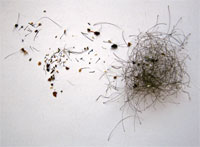|
| Fig. 66.1 Scale, scabs, and hair brought in by a patient with delusions of parasitosis who insists that these are parasites. |
These patients falsely believe that their skin is infested with parasites. They often describe insects mating, laying eggs, and crawling around in their skin. They do not admit to actually seeing the insects themselves, as they are not hallucinating. On presentation, patients may bring in specimens containing hair, lint, and even living organisms for examination (Fig. 66-1). They develop elaborate purification rituals and are often well known to pest control organizations. It is not uncommon for the delusion to be shared by other family members. This is called
folie à deux.
Of note is the fact that the delusion is often referred to as a monosymptomatic hypochondriacal psychosis. It is “circumscribed,” and patients tend to function well in other aspects of their lives; however, their delusional behavior is not corrected by either argument or evidence that they do not have an infestation.
Edlich RF, Cross CL, Wack CA, Long WB 3rd: Delusions of parasitosis,
Ann J Emerg Med 27:997–999, 2009.
